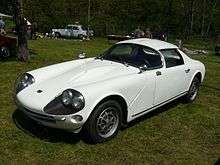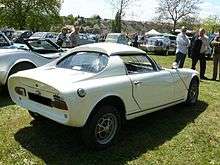Sovam
| Industry | Manufacturing |
|---|---|
| Founded | 1930 |
| Founder | André Morin |
| Headquarters | Parthenay, Deux-Sèvres, France |
| Products |
Cars (in the 1960s) specialist vehicles and other airport handling equipment) |
| Website |
www |


The SOciété des Véhicules André Morin (SOVAM) is a French company that specialises in mechanised handling equipment for airports, but with a past as an automobile manufacturer.
History
The business was established by André Morin in 1930, based on an existing car and carriage body workshop scale business created by his father, Robert Morin. Sovam developed a speciality as a manufacturer of mobile shops based on light truck mechanical components and went on to diversify into other lucrative niches. In 1962 Morin created the Etalmobil brand.
In 1964 the manufacturer introduced a “Véhicule Utilitaire de Livraison” (VUL/light delivery vehicle) which used a “fibre-glass” body mounted on the shortened chassis from a Renault 4. The vehicle was ideal for urban delivery work.
The next year, thanks to the commercial success of his other businesses, including the production of mobile shops, of airport handling equipment and of other specialist light utility vehicles, Morin calculated that he had the means to support the launch of a low volume sports car.[1] He was helped in this project by Jacques Durand[2] who would design the car bodies. The car was presented in October 1964 at the (model year 1965) Paris Motor Show. The interest it generated persuaded Morin to put it into production. The cars would be manufactured till 1968.
The company’s existing expertise in producing fibreglass vehicle bodies emabled the rapid development of a suitable frame and body to be mounted on the chassis of a Renault 4 with which, as with the “VUL” of 1964, provided the mechanical elements for the car. Renault also provided the windscreen, which came from their Floride model although, intriguingly, for fitting in the Sovam sports car the Floride windscreen was rotated through 180 degrees.
The line of the car was low and sporty, although not to everyone’s taste.[3] The 845cc engine from the Renault 4 delivered a level of performance that fell short of the car’s sporty style, but the listed price at this stage was just below 10,000 francs and the car managed to attract a few customers.
Initial sales volumes may nevertheless have been lower than envisaged, since the company soon let it be known that the car was underpriced. For 1966 the price was increased to 12,800 francs, and the price increase was supported by the switch to Renault’s recently introduced 1108cc engine which rendered the performance less anaemic.
For 1967 the car was offered, as an option, with the 1255cc engine from the Renault 8 Gordini. This provided a claimed maximum output of 103 hp (77 kW) (SAE) at 6750 rpm,[4] and when combined with a (still, in 1967, unusual) five speed transmission enabled the manufacturer to list a top speed of 195 km/h (121 mph) which was considered fast for this class of car. The 1108cc powered car, with a claimed 65 hp (48 kW) (SAE) of power provided for a 165 km/h (103 mph) maximum, while the original 845cc version was withdrawn during 1967.
By 1967 the Sovam sports car was not without its achievements. The unusual looks of the car nevertheless continued to attract criticism, and the Sovam failed to acquire the level of cachet achieved by competitor products such as the Alpine A110 and Matra 530. October 1967 marked the last of the manufacturer’s three appearances at the annual held Paris Motor Show.[1] It later turned out that during 1968 Morin had produced just 5 of his sports cars.[1] During the period 1965 – 1968, 160 of the cars had been produced.
The business continued to prosper, however, with a focus on supplying airports with special purpose vehicles and rolling walkways.
At the end of 2010 the business was acquired by a Russian businessman. He bought it from Siraga who had purchased Sovam in 1997.[5]
.jpg) La Sovam 1966
La Sovam 1966 La Sovam 1966
La Sovam 1966- La Sovam de 1967
- La Sovam de 1968
L'activité d'équipement d'aéroport débute au milieu des années 1970, les produits de catering, maintenance, fret, les passerelles, escaliers, etc. deviennent alors le métier principal de l'entreprise.
Dans le milieu des années 1980, la Sovam construit pour M. André Goldman le premier modèle d'un véhicule militaire, le Sovamag TC10 (SOVAM André Goldman). Il sera à partir de 1988 fabriqué industriellement et principalement pour l'export dans la toute nouvelle usine de Techni Industrie à Bonchamp-les-Laval (53), SOVAMAG devient alors SOciété des Véhicules Automobiles Michel André Goldman. A partir de 1992 la production est transférée vers l'usine Auverland de Saint Germain-Laval (42). Le nom de la marque restera un rappel au premier modèle.
Elle appartient depuis fin 2010 à un homme d'affaires russe, après avoir été rachetée en 1997 par Siraga.[5]
References
- 1 2 3 "Automobilia". Toutes les voitures françaises 1968 (salon [Paris Oct] 1967). Paris: Histoire & collections. Nr. 29: Pages 80–81. 2004.
- ↑ La Sovam sur le site Jidé-Scora
- ↑ "Automobilia: »… [André Morin]... n'avait pas prise suffisamment en compte un élément déterminant pour ce genre d'entreprise: l'aspect rédhibitoire du produit qu'il envisageait de diffuser. »". Toutes les voitures françaises 1968 (salon [Paris Oct] 1967). Paris: Histoire & collections. Nr. 29: Page 80. 2004.
- ↑ Changes in the way that power output was computed by European automakers did not take place overnight, and data from automakers provided during the late 1950s and early 1960s, as well as sources derived from then, usually do not spell out the computation basis used when quoting Horsepower (hp). Practice in France (and Britain) had since 1945 tended to follow North American practice, measuring "SAE" gross power whereby prior to measurement the engine was stripped of "auxiliary elements" such as filters, silencers/mufflers, pumps, dynamo/alternator and transmission. By removing most of the elements that absorbed engine power before it ever came near to the drive shaft, it was possible to maximise the horse-power figure. At the end of the 1950s the larger French and British automakers moved towards the (originally German) DIN standard which measured the power arriving at the drive shaft without removing the "auxiliary elements" from the engine. Smaller manufacturers followed suit, but sometimes, as in this case, not till some years later.
In practice there was far more variation in how horse power was measured and quoted than this necessarily simplistic summary allows, and there is no universal formula for converting an SAE horsepower figure to a DIN horsepower figure, but a reduction in the power figure quoted of perhaps 15% when switching to a DIN figure in most cases provides a reasonable approximation. - 1 2 Sovam vendu à un investisseur russe, sur actufax.com